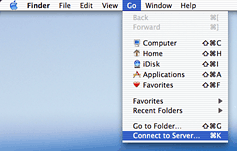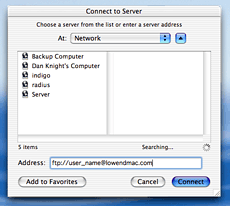|
|
Using Jaguar's
Finder for FTP
by Alan Zisman (c) 2003 First published in LowEndMac , February 11, 2003 X-Basics column FTP is an old Unix service that has a long history of being used to transfer files. In fact, email messages were originally text files transferred via FTP. Jaguar's Go/Connect to Server menu makes traditional FTP software (programs like Fetch) unnecessary for many people. Here's how to do it. 
In the Finder/Go/Connect to Server dialogue, if you type ftp://domain_name you'll be connected to an anonymous ftp server (if available). This might be just what you need. You'll be asked for authentication with user-name and password if that domain doesn't offer an anonymous ftp service. My web host, however, maintains an optional anonymous ftp service-- so if I type ftp://zisman.ca, I go there, rather than to my (password-protected) folders, which is where I want to go.
ftp://user_name@domain_name you'll get a log-in prompt, with the user name already filled in, waiting for you to enter the password. And if you type: ftp://user_name:password@domain_name you'll go right in with no log-in needed (assuming you typed everything correctly!). Of course, doing that, anyone looking over your shoulder can read your password. Unix fans will notice that there's nothing mysterious about this; it's all standard Unix FTP syntax. Once connected, a network drive icon will appear on the desktop; opening it allows you to copy files to your Mac from the remote FTP host. Of course, performance will be much more sluggish than working on a local system or on a local area network. (It appears that you can only copy to your Mac; to make changes to the remote site, you'll still need a 'real' ftp program). Some may prefer to use the Terminal's command line FTP service. That works fine, you just need to know a little bit more about what you're doing! |
|
|
|
|
| Alan Zisman is a Vancouver educator, writer, and computer specialist. He can be reached at E-mail Alan |
 If instead, you type
If instead, you type